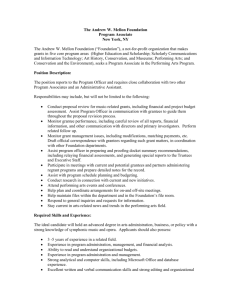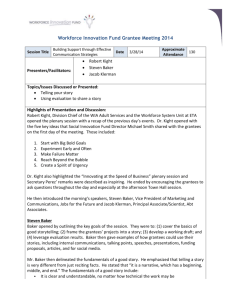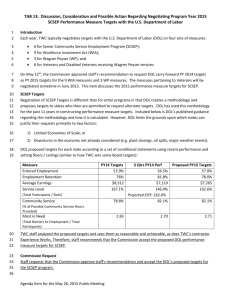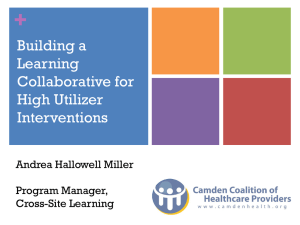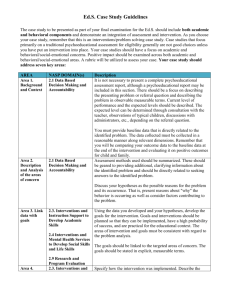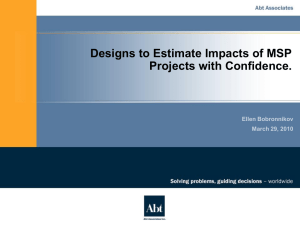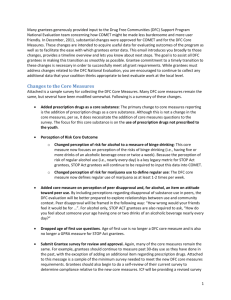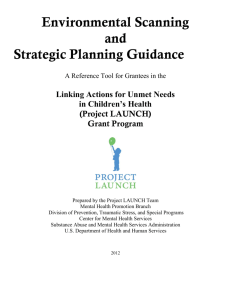The draft instruments currently under review are being - PEP-C
advertisement
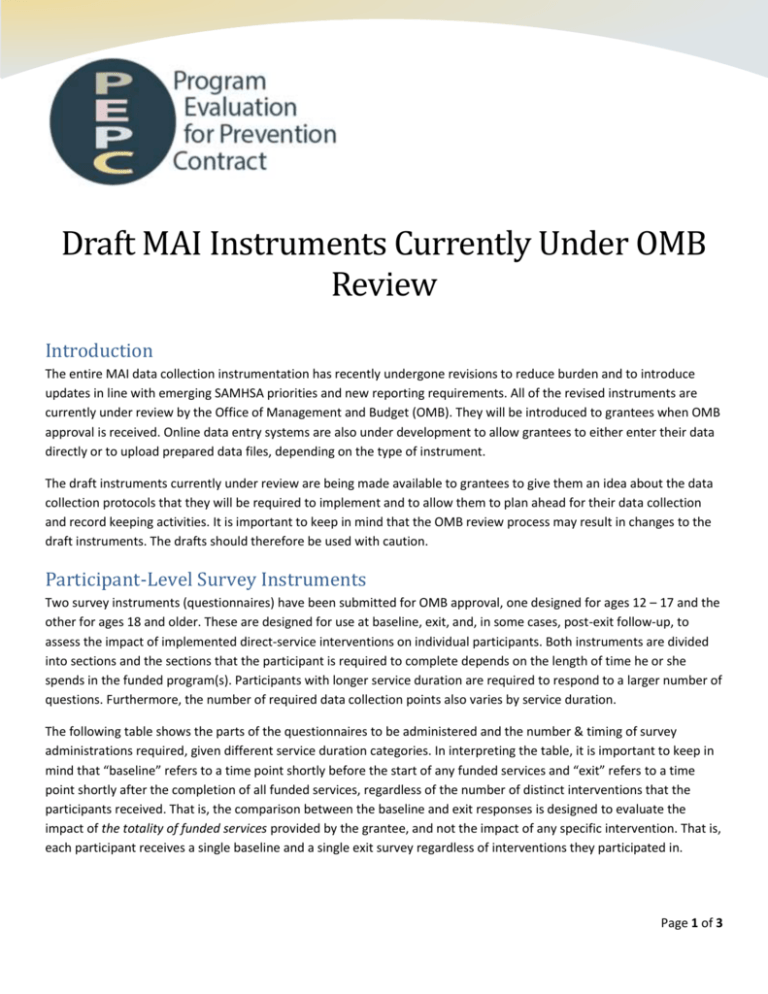
Draft MAI Instruments Currently Under OMB Review Introduction The entire MAI data collection instrumentation has recently undergone revisions to reduce burden and to introduce updates in line with emerging SAMHSA priorities and new reporting requirements. All of the revised instruments are currently under review by the Office of Management and Budget (OMB). They will be introduced to grantees when OMB approval is received. Online data entry systems are also under development to allow grantees to either enter their data directly or to upload prepared data files, depending on the type of instrument. The draft instruments currently under review are being made available to grantees to give them an idea about the data collection protocols that they will be required to implement and to allow them to plan ahead for their data collection and record keeping activities. It is important to keep in mind that the OMB review process may result in changes to the draft instruments. The drafts should therefore be used with caution. Participant-Level Survey Instruments Two survey instruments (questionnaires) have been submitted for OMB approval, one designed for ages 12 – 17 and the other for ages 18 and older. These are designed for use at baseline, exit, and, in some cases, post-exit follow-up, to assess the impact of implemented direct-service interventions on individual participants. Both instruments are divided into sections and the sections that the participant is required to complete depends on the length of time he or she spends in the funded program(s). Participants with longer service duration are required to respond to a larger number of questions. Furthermore, the number of required data collection points also varies by service duration. The following table shows the parts of the questionnaires to be administered and the number & timing of survey administrations required, given different service duration categories. In interpreting the table, it is important to keep in mind that “baseline” refers to a time point shortly before the start of any funded services and “exit” refers to a time point shortly after the completion of all funded services, regardless of the number of distinct interventions that the participants received. That is, the comparison between the baseline and exit responses is designed to evaluate the impact of the totality of funded services provided by the grantee, and not the impact of any specific intervention. That is, each participant receives a single baseline and a single exit survey regardless of interventions they participated in. Page 1 of 3 Participant-Level Survey Data Collection Schedule Participant’s Total Service Duration Questionnaire Section(s) to be Administered Data Collection Time Point(s) “Single Session” All of Section One and 3 to 5 relevant questions selected from Section Two Exit only All of Sections One and Two Baseline and exit Entire questionnaire (All of Sections One, Two, and Three) Baseline, exit, and 3-6month post-exit followup (no longer than a single day) “Multiple Session Brief” (2-29 days) “Multiple Session Long” (30+ days) Participant-Level Dosage Forms Every direct-service encounter with a program participant will be recorded in a dosage form. There are separate dosage forms for individual (one-on-one) and group service encounters. The forms both collect information about the type(s) of services provided during the encounter and the length of time (in minutes, rounded up to the next 5-minute interval) of exposure to each service type. Participant-Level Record Management Information Questionnaires and dosage forms both include fields for use in managing the data and most importantly, in linking together the multiple data records collected from an individual. These fields should always be completed by a trained program staff responsible for data coordination. It is especially important to keep in mind that the record management section of survey instruments should always be completed by program staff before the questionnaire is given to the participant. Inaccurate or missing data in the record management fields are the most common sources of data loss during cross-site evaluation. Page 2 of 3 Grantee-Level Quarterly Progress Report This is a tool that allows the grantees to submit their quarterly progress reports to SAMHSA. The reports are used by project officers in their grant management and monitoring. The information is also used by the Cross-Site team in process evaluation. The Quarterly Progress Report includes information about grantees’ progress through the Strategic Prevention Framework (SPF) process. Each section of the report addresses a SPF step. There are fields for entering information about needs assessment, capacity building, strategic planning, implementation, and evaluation. The Implementation section includes aggregate reporting of testing activities. HIV CBI grantees will also report on the vaccination services they provide in the Implementation section. In reporting progress during any given quarter, the grantees are required to only report in sections corresponding to the SPF step(s) that they worked on during that quarter. The online system will pre-fill data fields wherever appropriate and updates will be required when there are changes in pre-filled fields. In other words, each quarter’s report will be considerably shorter than the length suggested by the full instrument. The system will also allow grantees to upload documents that they want to share with their project officers, such as needs assessment reports, strategic plans, meeting minutes, etc. Grantee-Level Indirect Services Outcomes Reporting Tool All grantees are expected to implement indirect-service interventions (environmental strategies and information dissemination efforts) that are intended to have an impact on the entire community. In order to evaluate the effects of such interventions on the targeted community, grantees are required to select community-level outcome measures corresponding to the goals of their indirect interventions and to submit data aggregated to the community level, first at baseline (before the beginning of implementation) and then annually. The data may come from sources such as hospital records, college surveys, and administrative records maintained by state or local agencies such as traffic authorities, law enforcement, and departments of public health. The cross-site evaluation of community-level change will be based on effect sizes calculated by comparing baseline values of the measures with the most recently available updated values. Page 3 of 3

